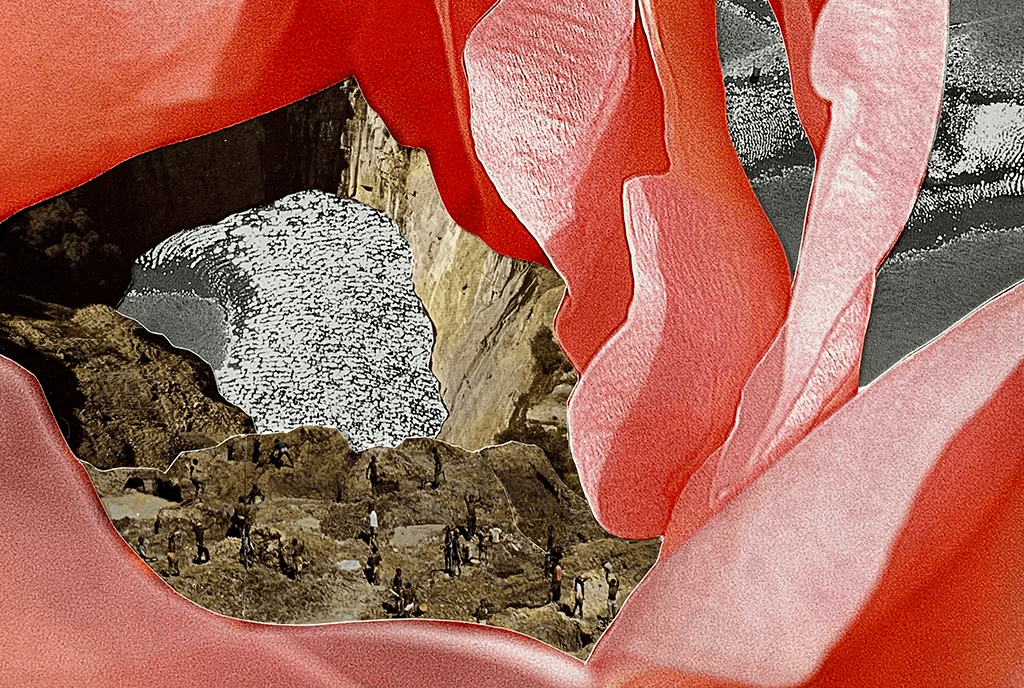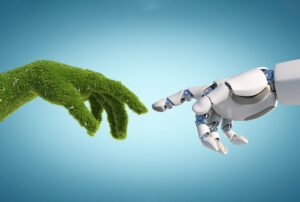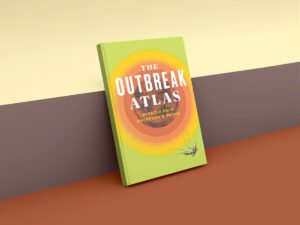
Editors’ note: This piece is from Nonprofit Quarterly Magazine’s fall 2023 issue, “How Do We Create Home in the Future? Reshaping the Way We Live in the Midst of Climate Crisis.”
I water you with tears even though I know better. How weak is the human spirit—my spirit—but not yours, dear Gaea, not yours.
The sun is bright—so bright, I have to shade my eyes to see us reflected in the panes of translucent fungus that light our dome.
Once upon a time, a long, long time ago, people built square and rectangular homes out of the bodies of murdered trees. A strange design. Nature doesn’t like sharp edges. Those ancient dwellings couldn’t breathe or bend in wind or storm. They couldn’t absorb the rains or floods. They could only resist the tempests that worsened each year. They were made to break and be broken.
I wonder, did our ancestors hear the screaming of the dead in their dreams? It was only after the planet—our planet, our home—was almost decimated that we learned to grow our domes and clothes from the intelligent weavings of mycelium. It seems so obvious now. Like a grass in a storm, like a cloud in the sky.
I watch us fitting together perfectly, like two puzzle pieces—and maybe we are: once, for nine months you grew inside of me, a part of me, like a bit of photosynthetic algae inside the lips of a giant clam.
Once upon a time, long before you or I were born, people and their machines seemed intent on destroying our planet, our home. Even as temperatures boiled and seas rose, men shot rockets into space, dreaming of nuclear weapons on Mars while playing on the dying seas in yachts larger than nightmare.
It’s nature—human nature. My nature. But not yours—not now.
It was then that your great-great-grandmother, Gaea I, began to understand. She was the first Gaea—the one whom all the women in our family are named after.
Gaea I worked with mycorrhizal fungi, the tiny root connections that reach beneath Earth and encircle the world, carrying messages. She loved this more than 500-million-years-old subterranean social network, this wood wide web, this earth connection.
“Fungi,” she wrote, “are in a kingdom of their own but are closer to animals than plants. They are old and wiser than us.”
So it was that the first Gaea in our family learned from the world beneath her, letting it teach her. Letting it save us.
She discovered thousands of different fungi, a “dark taxa,” mysterious as dark matter. From it she extracted itaconic acid, replacing plastic, synthetic rubber polystyrene foam, leather, and cement.
And as the sea rose, she grew rafts of mycelium that soaked up the water, expanding and enlarging until, slowly, they rose. And so, humanity survived the rising waters, drifting along the seas in fungal life rafts. And when she died, her body was wrapped in a mycelium coat and watered by the tears of her daughters to live again.
Her daughter, your great-grandmother, Gaea II, loved slime more than fungus. It’s an odd thing to love, but it saved our seas.
“Hagfish,” she wrote in journals I have kept and had hoped to pass on to you, “produce slime the way humans produce judgment—easily, rapidly, defensively, and copiously. This slime is one of nature’s most wondrous substances.
“It consists of two main components—mucus and protein threads. Each thread waits, coiled up in its own tiny cell—meters of sticky hairs stuffed into a tiny gland without a single knot or tangle. The threads are only one-hundredth the width of a whisker but can stretch out for about two hundred millimeters, creating a fast-expanding net.
“To create a liter of slime, a hagfish releases just 40 milligrams of mucus and protein—that’s 1,000 times less dry material than human saliva. That’s why the slime feels so incorporeal, like an underwater spider web. When you see it in a bucket, it looks like water. Only when you stick your hand in can you see the water has become congruent.”
Grandmother Gaea II made tubes of hollow bamboo that sucked water in and spat strands of hagfish slime mucus out, far into the sea, and pulled them back, covered in plastics.
And it worked. The seas were clean again. And when she died, she was wrapped in a slimy coat and allowed to sink back into the ocean she loved so much.
But it was not enough. The air was still heavy with CO2, and the oceans were hot, empty, and acidified.
It was your great-great-grandmother, Gaea III, who began breeding heat-resistant corals. She was a musician, and she grafted old recordings of healthy reefs onto the ends of the branches of dead and dying coral.
When the remaining fish, lonely in dark waters, heard the music of a long-silent reef calling to them, they came. And in their coming, the artificial sounds became real.
Algae are the engine of the sea, turning sunlight into nutrition for almost everything else, including coral. The algae turn light into food, giving the coral its color and providing 90 percent of its food. If the temperature is too hot or too cold, the algae become stressed and leave, or perhaps the coral polyps spit out the algae. It’s hard to know. You could probably tell me, dear child, if only I could understand.
Like coral, many species of giant clam have algae living in their lips, supplying extra food.
“Instead of containing a single alga,” wrote Grandmother Gaea III, “giant clams grow long, microscopic pillars of algae deep into their mantle.
“Animals such as starlings or butterflies use iridescence for display or camouflage, but giant clams have living iridescent cells that optimize the absorption of light to suit tiny stacks of algal cells.
“The iridocytes filter light, sending beneficial wavelengths to algae into the mantle, and scattering the more harmful wavelengths away.
“The living iridescence ensures that every last alga in the pillar gets its fill of sunlight, even though most of the 300 or so cells in each column have no direct access to the light.”
By imitating these columns, Grandmother Gaea III’s solar panels were able to charge hundreds of cells instead of one. Her iridescent panels provided energy wherever it was needed, as abundant and free as sunlight.
Sign up for our free newsletters
Subscribe to NPQ's newsletters to have our top stories delivered directly to your inbox.
By signing up, you agree to our privacy policy and terms of use, and to receive messages from NPQ and our partners.
Still, we lived sparsely. CO2 still clouded our horizon, as few plants had survived.
We think of green as the color of growth; but really it’s the only light plants aren’t using. You should know.
It was Grandmother Gaea II who realized that if photosynthesis used every color of light to make food, plants would be black. And so she began the black forest, planting shadow grasses that ate all light and sucked down carbon like candy.
The climate was now under control, but science is always more complex than we suppose. Systems are always more connected.
I grew up in the sheltering shadow of my mother, born through artificial sterilization because all our males were sterile. In a way it freed us. In a world where everyone is unnatural no one is odd. We were struggling to survive, and in that struggle, differences of sex, preferences in skin color, disappeared. (Without clouds, there are no silver linings.)
Then a miracle happened. Some women, I among them, got pregnant. Maybe it was the sea starting to live again—or the sun, no longer deadly—that caused our wombs to blossom. We didn’t know. But ignorance didn’t dampen our joy.
Usually, our children are sterile. Other offspring—well, other offspring are like you, my sweet, perfect child, the last Gaea. The scientific name is anorexia viridis, but most people just call it The Greening.
At first, we didn’t understand. At first, we thought it was something to fear. A disaster. A takeover. Another way to die.
We were wrong. It is rebirth. It is reincarnation. It is salvation.
I remember when you were conceived. When I held you, your gaze searched my face so intently, I felt that you could see into my soul. I was not prepared for the joy that burying my face in the nape of your tiny neck gave me. I had never imagined I would ever again smell freshness, possibility, the fragrance of a brighter future. It was like breathing 22 percent oxygen.
Your happiness was infectious, a contagion of hope. We were on the mend. We had free solar power, black forests that cleaned the skies, and we had love.
We were so proud when you walked and talked. For you, every step was a dance, every word a poem. Your voice, high and sweet, made me think of descriptions of ancient birdsong. You described the commonest things in words that made me look at them anew: the droplets condensing on the fungal dome’s surface became tiny, iridescent replicas of our world; the reddish mists rising from the algae vaults transformed into clouds of glory.
Your fanciful metaphors, those stopped first. Your speech grew simpler. I thought it was a sign of maturity. I scolded myself for missing your curious sideways view of life. But even if I had understood, what could I have done?
By eight you’d stopped dancing. By ten, you ceased walking. You sat cross-legged on the floor in a corner, soaking up the wan rays of the sun that permeated the dome. I missed your birdsong voice and the rhythm of your steps; but mostly I missed your laughter, that spontaneous burbling up of joy, that contagion of happiness.
I brought you food. I read you books. I pleaded with you. I slapped your unresponsive face. Your smile didn’t even fade—not at first. But each day it grew dimmer, features retreating into blankness.
I tell myself that I am fortunate. And I wonder. I wonder about movement and sentience. I wonder what you, green head filled with light, are feeling? Do you recall our games of hide and seek, our tales of magic and wonder? Did you love me? Do you miss me?
Humankind looks in the mirror and says, “That is beautiful. That is smart. I am the master of the universe.”
I look at you, my small, motionless, verdant child. I bury my nose in your flesh, trying to locate a fresh baby scent, but smell only a vegetable moistness.
In an earlier time, you would have provided food for animals and a place to live for birds. Even now, you clean our planet with each breath.
And I wonder, which species is superior?
And I wonder, when you so clearly have a reason for being, why is this so hard?
Why do I mourn this gift? Why do I feel I have lost you?
You are what you were meant to be. What you need to be. What we need you to be.
And with that epiphany, with you cradled in my arms, turned toward the light, you seem a part of me again—or am I becoming a part of you?
I wept the day you lost your eyes—watching as they gradually turned into buds and sprouted leaves. How could I have been so blind as to imagine humans as superior, to consider ourselves the peak of evolution?
You are the miracle. You filter our water with your roots. You cleanse our planet with your breath. You eat sunlight. You will give the world back its green.
My greatest achievement will always be having given birth to you, Gaea, my Gaea. My greatest sorrow was not accepting your change.
Today I will set you gently into the earth, sticking my fingers into the soil, feeling for root connections, intimate as when you were in my womb.
How smart of evolution to make our connection to Earth more apparent now, our ties familial. We have always been just another part of the great cycle—we just didn’t know it.










